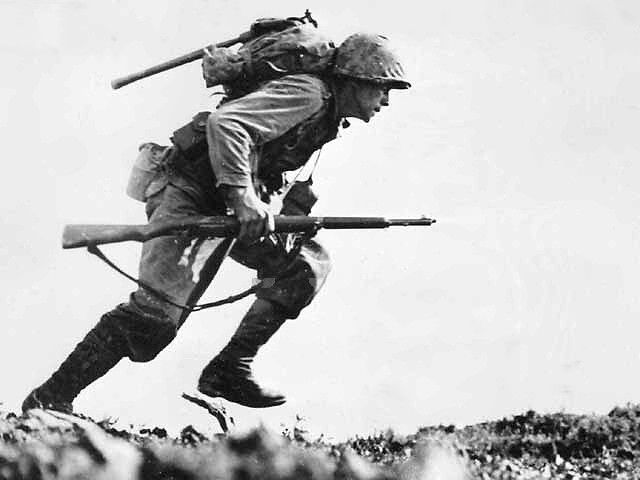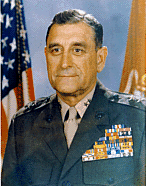Monday, March 18, 2013
United State Marine Corps
Medal of Honor recipient
Major General James Lewis Day (October 5, 1925 - October 28, 1998) was a United States Marine, who as a Corporal, during World War II in the Battle of Okinawa, displayed "extraordinary heroism, repeated acts of valor, and quintessential battlefield leadership, ...inspired the efforts of his outnumbered Marines to defeat a much larger enemy force", for which he was ultimately received the Medal of Honor. Day continued his distinguished service with the Marine Corps as an officer, reaching the rank of Major General.
Biography
James Day was born October 5, 1925, in East St. Louis, Illinois. He enlisted in the United States Marine Corps in 1943.
Day participated in combat action during World War II in the Marshall Islands, on Guam and on Okinawa, where for his heroic actions during the fight for Sugar Loaf Hill he was later awarded the Medal of Honor.
Day holds a Bachelor of Science degree in Political Science and a Masters of Business Administration degree.
In September 1952, he completed The Basic School at Quantico, Virginia, and was transferred to Korea where he served with Company C, 1st Battalion, 7th Marines and the 1st Reconnaissance Company.
First Lieutenant Day served as the S-3 officer, Marine Corps Supply Center, Barstow, California, until July 1954, when he was transferred to Camp Pendleton, California, for duty as Commanding Officer, Company C, Marine Corps Test Unit One. He was promoted to captain in December 1954. Capt Day remained at Camp Pendleton until May 1956, and was then assigned as Operations Officer of the Recruit Training Command, Marine Corps Recruit Depot San Diego.
In September 1957, he was transferred to Okinawa and served as Commanding Officer, 4.2 Mortar Company, and later served as a battalion operations officer with the 9th Marines, 3rd Marine Division. Returning stateside in December 1958, he was assigned as Instructor, Tactics Group, The Basic School, Quantico. He was promoted to major in August 1962 and attended the Amphibious Warfare School, also at Quantico.
Major Day was transferred to the 4th Marine Corps District in July 1963 and served as Inspector-Instructor, 43rd Rifle Company, Cumberland, Maryland. In April 1966, Maj Day served his first tour in Vietnam as Commanding Officer, 1st Battalion, 9th Marines, 3rd Marine Division. Returning to Camp Pendleton in June 1967, he was assigned as the Commanding Officer, 1st Battalion 28th Marines, 5th Marine Division.
He was promoted to lieutenant colonel in July 1967 and in January 1968, he was reassigned as Battalion Commander, 2nd Infantry Training Regiment, Camp Pendleton.
Lieutenant Colonel Day served at Pearl Harbor, Hawaii, from July 1969 to June 1971 and attended the Army War College, Carlisle Barracks, Pennsylvania, from July 1971 to June 1972. After graduation, he served his second tour in Vietnam as Operations Officer, 9th Marine Amphibious Brigade, III Marine Amphibious Force. He was reassigned as Commanding Officer, Camp Fuji, Japan, in March 1973.
He was promoted to Colonel in November 1973 and was transferred to Philadelphia for duty as Deputy Director, and later, Director, 4th Marine Corps District. He remained in that billet until April 1, 1976, when he was advanced to Brigadier General. He assumed duties as Assistant Depot Commander, Marine Corps Recruit Depot San Diego, in May 1976, and on November 1, 1977, he became Commanding General of the Depot, serving in that capacity until March 11, 1978.
On April 29, 1978, he was assigned duty as Deputy Director for Operations, J-3, NMCC, Joint Chiefs of Staff, Washington, D.C. During July 1979, BGen Day was assigned duty as the Assistant Division Commander, 1st Marine Division/Commanding General, 7th Marine Amphibious Brigade, Fleet Marine Force, Pacific, Camp Pendleton. He was promoted to major general on August 1, 1980, and assumed duty as the Commanding General, 1st Marine Division, and was ultimately assigned the additional duty as Commanding General, I Marine Amphibious Force, on July 1, 1981. He served in that capacity until August 1982 when he was assigned duty as the Deputy Chief of Staff for Training, Headquarters, U.S. Marine Corps, Washington, D.C. In July 1984, he was assigned duty as the Commanding General, Marine Corps Base Camp Smedley D. Butler/Deputy Commander, Marine Corps Bases, Pacific (Forward)/Okinawa Area Coordinator, Okinawa, Japan. He served in this capacity until his retirement on December 1, 1986. Upon his retirement, he was presented the Navy Distinguished Service Medal for exceptionally meritorious service to the Government of the United States for duties while serving in his final duty station.
Major General Day was presented the Medal of Honor on January 20, 1998, over a half a century after the World War II battle on Okinawa in which he distinguished himself.
He died of a heart attack later that year on October 28, 1998 in Cathedral City, California. He was laid to rest in Fort Rosecrans National Cemetery, San Diego, California.
Decorations
Major General Day's personal decorations incl
Medal of Honor citation
While a Corporal in World War II, James L. Day's heroism at Okinawa in 1945, while serving with the 2nd Battalion, 22nd Marines, 6th Marine Division was honored with the nation's highest award, the Medal of Honor. The citation reads:
- The President of the United States in the name of the Congress takes pleasure in presenting the MEDAL OF HONOR to
CORPORAL JAMES L. DAYUNITED STATES MARINE CORPS RESERVE
for service as set forth in the following CITATION:
For conspicuous gallantry and intrepidity at the risk of his life above and beyond the call of duty as a squad leader serving with the Second Battalion, Twenty-Second Marines, Sixth Marine Division, in sustained combat operations against Japanese forces on Okinawa, Ryukyu Islands from 14 to 17 May 1945. On the first day, Corporal Day rallied his squad and the remnants of another unit and led them to a critical position forward of the front lines of Sugar Loaf Hill. Soon thereafter, they came under an intense mortar and artillery barrage that was quickly followed by a fanatical ground attack of about forty Japanese soldiers. Despite the loss of one-half of his men, Corporal Day remained at the forefront, shouting encouragement, hurling hand grenades, and directing deadly fire thereby repelling the determined enemy. Reinforced by six men, he led his squad in repelling three fierce night attacks but suffered five additional Marines killed and one wounded whom he assisted to safety. Upon hearing nearby calls for corpsman assistance, Corporal Day braved heavy enemy fire to escort four seriously wounded Marines, one at a time, to safety. Corporal Day then manned a light machine gun assisted by a wounded Marine, and halted another frenzied night attack. In this ferocious action, his machine gun was destroyed, and he suffered multiple white phosphorus and fragmentation wounds. Assisted by only one partially effective man, he reorganized his defensive position in time to halt a fifth enemy attack with devastating small arms fire. On three separate occasions, Japanese soldiers closed to within a few feet of his foxhole, but were killed by Corporal Day. During the second day, the enemy conducted numerous unsuccessful swarming attacks against his exposed position. When the attacks momentarily subsided, over 70 enemy dead were counted around his position. On the third day, a wounded and exhausted Corporal Day repulsed the enemy's final attack and dispatched around 12 of the enemy at close range. Having yielded no ground and with more than 100 enemy dead around his position, Corporal Day preserved the lives of his fellow Marines and made a primal contribution to the success of the Okinawa campaign. By his extraordinary heroism, repeated acts of valor, and quintessential battlefield leadership, Corporal Day inspired the efforts of his outnumbered Marines to defeat a much larger enemy force, reflecting great credit upon himself and upholding the highest traditions of the Marine Corps and the United States Naval Service.
Other honors
A Golden Palm Star on the Palm Springs Walk of Stars was dedicated to Day for Veterans Day in 1999, recognizing him as one of five Medal of Honor recipients from the Southern California desert area.Friday, March 1, 2013
SUNDAY - March 17 Celebrated in NYC this
year on Saturday <> March 16
"On the streets of New York since 1762 - the oldest, largest, and best in the world" The parade marches up 5th Avenue, clan by clan. The Parade starts at 44th Street at 11 am and is held every March 17th, except when March 17th falls on a Sunday, it is celebrated the day before, Saturday the 16th because of religious observances.
The parade marches up Fifth Avenue past St. Patrick's Cathedral at 50th Street all the way up past the American Irish Historical Society at 83rd and the Metropolitan Museum of Art at 83rd Street to 86th Street, where the parade finishes around 4:30 - 5:00 pm
"The St. Patrick's Day Parade is one of New York City's greatest traditions. On this day, everyone is Irish in the Big Apple!
The Parade marched for the first time on March 17, 1762 - fourteen Years before the Declaration of Independence was adopted and today it is the largest Parade in the World.
This annual parade has been held for the past 247 years in honor of the Patron Saint of Ireland and the Archdiocese of New York. The Parade is reviewed from the steps of Saint Patrick's Cathedral by His Eminence Cardinal Edward Eagan, Archbishop of New York in the same manner as the Archbishop of New York did in the early days of the Parade at the Old St. Patrick's Cathedral in Lower Manhattan when the Parade was held in Lower Manhattan before the new St Patrick’s was built on Fifth Avenue.
Often regarded as the most popular parade in New York City, the Parade is the largest and most famous of the many parades held in the city each year."
Subscribe to:
Comments (Atom)







